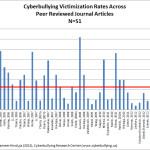
It’s been nearly three years since I posted a summary of the current state of cyberbullying research on this blog. That post was inspired by my concern that no researchers were included on a panel that testified to the Committee on Education and Labor’s Subcommittee on Healthy Families and Communities on the topic of how teens were using and misusing technology. I was troubled then, and remain concerned that quality research about cyberbullying has not been making it into mainstream discussions in the media, even though research in this area has flourished. I want to take a moment to update readers on what we know about cyberbullying based on our research – and that of others who have been exploring this problem.
Our Studies
Over the last decade, Sameer and I have surveyed more than 20,000 middle and high school students in twelve different studies from over 80 different schools throughout the United States. The first two studies were online exploratory samples used to obtain a general understanding of the problem, so the numbers obtained are higher than average and not representative because they only include online teens who volunteered to participate. Our seven most recent studies, however, have all been random samples of known populations in schools so we can be fairly confident in the reliability and validity of the data obtained (click here for more information about the methodology). Overall, about 28% of the students we have surveyed over the last ten studies have told us that they have been cyberbullied at some point in their lifetimes. About 8% said they were cyberbullied in the 30 days preceding the survey. Similarly, about 16% of those who we surveyed admitted that they had cyberbullied others at some point in their lifetimes (about 6% in the most recent 30 days).
Other Published Research
This past summer, Sameer and I (along with one of my undergraduate students) reviewed all of the published research we could find that included prevalence rates for cyberbullying. This work built on our earlier effort to quantitatively summarize published cyberbullying articles which we wrote about in our book Cyberbullying Prevention and Response: Expert Perspectives (see especially chapter 2). In total, we have now reviewed 73 articles published in peer-reviewed academic journals. Fifty-one of those included cyberbullying victimization rates and 42 included cyberbullying offending rates. As you can see from the charts below (click to enlarge), rates across all of the studies ranged widely, from 2.3% to 72% for victimization and from 1.2% to 44.1% for offending. The average across all of these studies was remarkably similar to the rates that we found in our work (about 21% of teens have been cyberbullied and about 15% admitted to cyberbullying others at some point in their lifetimes). Taken as a whole, it seems safe to conclude that about one out of every four teens has experienced cyberbullying, and about one out of every six teens has done it to others.
- Cyberbullying Victimization
- Cyberbullying Offending
A couple of other broad generalizations can be made about cyberbullying, based on recent research:
– Adolescent girls are just as likely, if not more likely than boys to experience cyberbullying (as a victim and offender) (Floros et al., 2013; Kowalski et al., 2008; Hinduja & Patchin, 2009; Schneider et al., 2012)
– Cyberbullying is related to low self-esteem, suicidal ideation, anger, frustration, and a variety of other emotional and psychological problems (Brighi et al., 2012; Hinduja & Patchin, 2010; Kowalski & Limber, 2013; Patchin & Hinduja, 2010; Wang, Nansel, & Iannotti, 2011)
– Cyberbullying is related to other issues in the ‘real world’ including school problems, anti-social behavior, substance use, and delinquency (Hinduja & Patchin, 2007; Hinduja & Patchin, 2008; Kowalski & Limber, 2013)
– Traditional bullying is still more common than cyberbullying (Lenhart, 2007; Smith et al., 2008; Wang, Nansel, & Iannotti, 2011)
– Traditional bullying and cyberbullying are closely related: those who are bullied at school are bullied online and those who bully at school bully online (Hinduja & Patchin, 2009; Kowalski & Limber, 2013; Ybarra, Diener-West, & Leaf, 2007).
Cyberbullying Trends
There are only two studies that we are aware of that have explored cyberbullying experiences over time. The first analysis was conducted by our friends at the Crimes Against Children Research Center at the University of New Hampshire. Examining the three waves of the Youth Internet Safety Survey (2000, 2005, 2010), they find a slight increase in cyberbullying behaviors over that time period (from 6% to 9% to 11%). The second data source is the School Crime Supplement of the National Crime Victimization Survey (NCVS). In 2011, 9% of students said they were cyberbullied compared to 6.2% in 2009. Since the NCVS data are weighted to represent the entire population of 12-18 year-olds enrolled in grades 6 through 12, we can estimate that about 2.2 million students experienced cyberbullying in 2011, up from about 1.5 million in 2009. Overall, even though we don’t have a lot of good research to go on, it seems reasonable to presume a slight increase in cyberbullying behaviors over the last few years.
I should acknowledge, however, that a recent poll from MTV and the AP released last month seemed to suggest a decrease in cyberbullying behaviors. I haven’t been able to examine the full methodology of that poll so it is difficult to know exactly what is going on, but I am suspicious since the numbers reported overall (49% cyberbullied in 2013 compared to 56% in 2011) are significantly higher than those in the peer-reviewed published literature that I summarized above.
Snapshot of Some Recent Data
We also just collected data (October, 2013) from about 400 students at one middle school (ages ranged from 11-14) in the Midwest. We haven’t had a chance to fully examine the results, but here are some quick stats:
– 97.5% have been online in the previous 30 days
– 63% have a cell phone
– 45% are on Facebook
– 42% are on Instagram
– 11.5% have been the target of cyberbullying in the previous 30 days (boys: 6.8%; girls: 16.0%)
– 3.9% have cyberbullied others in the previous 30 days (boys: 0.6%; girls: 6.9%)
Where Do We Go From Here
We have come a long way in a relatively short amount of time, but more research is still necessary. Public attention to the problem of cyberbullying is at an all-time high. As such, good research is necessary to contribute evidence-based insight into the nature of this problem and its possible solutions. Cyberbullying scholarship must continue to advance by improving methodological standards, including the use of validated measures, representative samples, and, where possible, longitudinal data. Supplementing quantitative findings with those from thoughtful and comprehensive qualitative inquiries will also help to better understand the precise nature of some of these relationships. With these considerations in mind, research will be better able to inform the public conversation about cyberbullying in a way that equips educators, parents, policy makers, and others with the information they need to make a positive difference in the lives of adolescents, online and offline.
References
Brighi, A., Melotti, G., Guarini, A., Genta, M. L., Ortega, R., Mora-Merchán, J., Smith, P. K. and Thompson, F. (2012). Self-Esteem and Loneliness in Relation to Cyberbullying in Three European Countries, in Cyberbullying in the Global Playground: Research from International Perspectives (eds Q. Li, D. Cross and P. K. Smith), Wiley-Blackwell, Oxford, UK.
Floros, G.D., Simos, K. E., Fisoun, V., Dafouli, E., and Geroukalis, D. (2013). Adolescent online cyberbullying in Greece: The impact of parental online security practices, bonding, and online impulsiveness. Journal of School Health, 83(6), 445-453.
Hinduja, S. & Patchin, J. W. (2007). Offline consequences of online victimization: School violence and delinquency. Journal of School Violence, 6(3), 89-112.
Hinduja, S. & Patchin, J. W. (2008). Cyberbullying: An exploratory analysis of factors related to offending and victimization. Deviant Behavior, 29(2), 129-156.
Hinduja, S. & Patchin, J. W. (2009). Bullying beyond the Schoolyard: Preventing and Responding to Cyberbullying. Thousand Oaks, CA: Sage Publications.
Hinduja, S. & Patchin, J. W. (2010). Bullying, cyberbullying, and suicide. Archives of Suicide Research, 14(3), 206-221.
Hinduja, S. & Patchin, J. W. (2012). Cyberbullying: Neither an Epidemic Nor a Rarity. European Journal of Developmental Psychology, 9(5), 539-543.
Kowalski, R. M. & Limber, S. P. (2013). Psychological, Physical, and Academic Correlates of Cyberbullying and Traditional Bullying. Journal of Adolescent Health, 53(1), S13-S20.
Kowalski, R. M., Limber, S. P. & Agatston, P.W. (2008). Cyber Bullying: Bullying in the Digital Age. Malden, MA: Wiley-Blackwell.
Lenhart, A. (2007). Cyberbullying and Online Teens. Pew Internet & American Life Project, June
27. (http://www.pewinternet.org/PPF/r/216/report_display.asp).
Patchin, J. W. & Hinduja, S. (2010). Cyberbullying and self-esteem. Journal of School Health, 80(12), 614-621.
Patchin, J. W. & Hinduja, S. (2013). Cyberbullying among Adolescents: Implications for Empirical Research. Journal of Adolescent Health 53(4), 431-432.
Schneider, S.K., O’Donnell, L, Stueve, A., and Coulter, R.W.S. (2012). Cyberbullying, school bullying, and psychological distress: A regional census of high school students. American Journal of Public Health, 102(1), 171-177.
Smith, P. K., Mahdavi, J., Carvalho, M., Fisher, S., Russell, S., and Tippett, N. (2008). Cyberbullying: its nature and impact in secondary school pupils. Journal of Child Psychology and Psychiatry 49(4): 376–385.
Wang, J., Nansel, T. R., & Iannotti, R. J. (2011). Cyber Bullying and Traditional Bullying: Differential Association with Depression. Journal of Adolescent Health, 48(4): 415–417.
Ybarra, M., Diener-West, M., & Leaf, P. J. (2007). Examining the Overlap in Internet Harassment and School Bullying: Implications for School Intervention. Journal of Adolescent Health, 41: S42–S50.
Ybarra, M. L., Espelage, D. L., & Mitchell, K. J. (2007). The Co-occurrence of Internet Harassment and Unwanted Sexual Solicitation Victimization and Perpetration: Associations with Psychosocial Indicators, Journal of Adolescent Health, 41, S31-S41.










Is there any way to stop harassment on a website that doesn’t follow it’s own T.O.S. and allows cyberbullying of members?
I would imagine this has to do with the culture of the moderators. The moderators would either enforce the terms of service or the terms of service would reflect the environment that the moderators allow.
Yes. Stop going on it. Problem solved.
Really? You must not understand the problem. Someone can cyberbully another person on Facebook, for example, even if that person is not on Facebook. They can create a fake profile or distribute mean pictures or spread rumors about that person, just to name a few ways. So how exactly is the “problem solved” by the teen not “going on it?”
poop
Is there any way to stop harassment on a website that doesn’t follow it’s own T.O.S. and allows cyberbullying of members?
Hi, im doing a research about cyberbullying and believe that girls cyberbully more than boys. In a few summary’s you write that girls cyberbully more (also it is shown in one of your tables), but i cant find it in your scientifcal articles. Can u tell me in which scientific articles u proved this? Thank u very much! Dear regards, Laurens.
hi, i am aslo doing research into cyberbullying and i was hoping you may be able to help. i was wanting to see if there was anymore research in recent years about if cyberbullying increased or decreased and rather or not the raised awareness is making an impact. if you could reply back i would really appreciate it thank you. 🙂
Unbelievable! I had no idea that the statistics were so high!
I agree that we do need to hear more about cyber-bullying in the media.
[…] CRC survey of one Midwest center propagandize found that some-more than 40 percent of a students were on […]
[…] CRC survey of one Midwest center propagandize found that some-more than 40 percent of a students were on […]
[…] CRC survey of one Midwest center propagandize found that some-more than 40 percent of a students were on […]